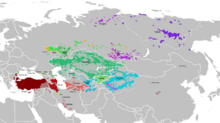துருக்கிய மக்கள் குழு
துருக்கிய மக்கள் குழு (Turkic peoples) என்பது நடு, கிழக்கு, வடக்கு மற்றும் மேற்கு ஆசியா மற்றும், ஐரோப்பா மற்றும் வட ஆப்பிரிக்க பகுதிகளின் இன மொழிக் குழுக்களின் தொகுப்பு ஆகும். இவர்கள் தற்கால தெற்கு சைபீரியா மற்றும் மங்கோலியா ஆகிய பகுதிகளில் வாழ்ந்த மக்கள் என்று கருதப்படுகின்றனர். இவர்கள் மேற்கு லியாவோ ஆற்றுப் படுகையில் (தற்கால மஞ்சூரியா) தங்களது பூர்வீகத்தை உடையவர்கள் என்று கருதப்படுகிறது. துருக்கிய மக்கள் துருக்கிய மொழி குடும்பத்தைச் சேர்ந்த ஏதாவது ஒரு மொழியை பேசுகின்றனர்.[37] இம்மக்கள் குறிப்பிட்ட கலாச்சார பண்புகள், பொதுவான முன்னோர் மற்றும் வரலாற்று பின்புலங்களை கொண்டுள்ளனர்.
காலப்போக்கில் பிற இனங்களுடன் தொடர்புக்கு வந்த துருக்கிய குழுக்கள் அவர்களை தங்களது இனத்தில் சேர்த்துக் கொண்டனர். இதன் காரணமாக ஒரு சில முக்கிய குழுக்கள் மற்ற துருக்கிய குழுக்களை விட பன்முகத் தன்மை உடையனவாக உள்ளன. பல வேறுபட்ட இனக் குழுக்கள் வரலாறு முழுவதும் மொழி மாற்றம், அந்நிய கலாச்சாரம் ஏற்பு, இனக்கலப்பு மற்றும் மத மாற்றம் காரணமாக துருக்கிய மக்களின் ஒரு பகுதியினராக மாறியுள்ளனர். இதன்காரணமாக மரபணுவை பொருத்தவரையில், பெரும்பாலான துருக்கிய குழுக்கள் அவற்றின் தோற்றத்தில் ஒரு குழுவில் இருந்து மற்றொரு குழுவிற்கு பெருமளவு வேறுபடுகின்றனர்.
குறிப்புகள்
[தொகு]மேற்கோள்கள்
[தொகு]- ↑ Yunusbayev et al. 2015.
- ↑ Garibova, Jala (2011), "A Pan-Turkic Dream: Language Unification of Turks", in Fishman, Joshua; Garcia, Ofelia (eds.), Handbook of Language and Ethnic Identity: The Success-Failure Continuum in Language and Ethnic Identity Efforts, ஒக்ஸ்போர்ட் பல்கலைக்கழகப் பதிப்பகம், p. 268, பன்னாட்டுத் தரப்புத்தக எண் 978-0-19-983799-1,
Approximately 200 million people,... speak nearly 40 Turkic languages and dialects. Turkey is the largest Turkic state, with about 60 million ethnic Turks living in its territories.
- ↑ Hobbs, Joseph J. (2017), Fundamentals of World Regional Geography, Cengage, p. 223, பன்னாட்டுத் தரப்புத்தக எண் 978-1-305-85495-6,
The greatest are the 65 million Turks of Turkey, who speak Turkish, a Turkic language...
- ↑ "Uzbekistan". Statistics Committee of the Republic of Uzbekistan. 19 August 2021. பார்க்கப்பட்ட நாள் 13 February 2022. "Population: 34,600,000 (January 2021 est.)" "Ethnic groups: Uzbek 84.6%, Russian 2.1%, Tajik 4.9%, Kazakh 2.4%, Karakalpak 2.2%, other 4.1% (2021 est.)" Assuming Uzbek, Kazakh and Karakalpak are included as Turks, 84.6% + 2.4% + 2.2% = 89.2%. 89.2% of 34.6m = 31.9m
- ↑ "Azerbaijani (people)". Encyclopædia Britannica. (15 million)
- ↑ Egbert Jahn, (2009). Nationalism in Late and Post-Communist Europe, p. 293 (20 mil)
- ↑ Library of Congress – Federal Research Division – Country Profile: Iran, May 2008, page 5 [1]
- ↑ "Kazakhstan". The World Factbook. பார்க்கப்பட்ட நாள் 21 December 2014. "Population: 17,948,816 (July 2014 est.)" "Ethnic groups: Kazakh (Qazaq) 63.1%, Russian 23.7%, Uzbek 2.9%, Ukrainian 2.1%, Uighur 1.4%, Tatar 1.3%, German 1.1%, other 4.4% (2009 est.)" Assuming Kazakh, Uzbek, Uighur and Tatar are included as Turks, 63.1% + 2.9% + 1.4% + 1.3% = 68.7%. 68.7% of 17.9m = 12.3m
- ↑ "China". The World Factbook. பார்க்கப்பட்ட நாள் 13 May 2014.
- ↑ "Azerbaijan". The World Factbook. பார்க்கப்பட்ட நாள் 30 July 2016. "Population: 9,780,780 (July 2015 est.)"
- ↑ "Census 2021: 84.6% of population define themselves as Bulgarians, 8.4% Turks, 4.4% Roma". 24 November 2022.
- ↑ "Afghanistan". The World Factbook. பார்க்கப்பட்ட நாள் 13 May 2014.
- ↑ "Uzbeks and Turkmens – Minorities and indigenous peoples in Afghanistan". World Directory of Minorities and Indigenous Peoples. 19 June 2015.
- ↑ Turner, B. (7 February 2017). The Statesman's Yearbook 2007: The Politics, Cultures and Economies of the World (in ஆங்கிலம்). Springer. p. 1238. பன்னாட்டுத் தரப்புத்தக எண் 978-0-230-27135-7.
- ↑ Leitner, Gerhard; Hashim, Azirah; Wolf, Hans-Georg (11 January 2016). Communicating with Asia: The Future of English as a Global Language (in ஆங்கிலம்). Cambridge University Press. p. 241. பன்னாட்டுத் தரப்புத்தக எண் 978-1-107-06261-0.
- ↑ Dresser, Norine (7 January 2011). Multicultural Manners: Essential Rules of Etiquette for the 21st Century (in ஆங்கிலம்). Wiley. p. 270. பன்னாட்டுத் தரப்புத்தக எண் 978-1-118-04028-7.
- ↑ "Unpublished Census Provides Rare and Unvarnished Look at Turkmenistan". https://jamestown.org/program/unpublished-census-provides-rare-and-unvarnished-look-at-turkmenistan/.
- ↑ "First (actual) demographic data for Turkmenistan released" (in en). www.asianews.it. https://www.asianews.it/news-en/First-(actual)-demographic-data-for-Turkmenistan-released-33436.html.
- ↑ "Kyrgyzstan". The World Factbook. பார்க்கப்பட்ட நாள் 13 May 2014.
- ↑ Triana, María (2017), Managing Diversity in Organizations: A Global Perspective, Taylor & Francis, p. 168, பன்னாட்டுத் தரப்புத்தக எண் 978-1-317-42368-3
- ↑ Bassem, Wassim (2016). "Iraq's Turkmens call for independent province". Al-Monitor. Archived from the original on 17 October 2016.
- ↑ "Tajikistan". The World Factbook. பார்க்கப்பட்ட நாள் 13 May 2014.
- ↑ "Obama, recognize us". St. Louis American. Archived from the original on 5 September 2014. பார்க்கப்பட்ட நாள் 18 March 2015.
- ↑ Nahost-Informationsdienst ( பன்னாட்டுத் தர தொடர் எண் 0949-1856): Presseausschnitte zu Politik, Wirtschaft und Gesellschaft in Nordafrika und dem Nahen und Mittleren Osten. Autors: Deutsches Orient–Institut; Deutsches Übersee–Institut. Hamburg: Deutsches Orient–Institut, 1996, seite 33.
- ↑ "All-Ukrainian population census 2001 – General results of the census – National composition of population". State Statistics Committee of Ukraine. 2003. பார்க்கப்பட்ட நாள் 2 September 2017.
- ↑ TRNC SPO, Economic and Social Indicators 2014, pages=2–3
- ↑ Michael, Michális (29 April 2016). Reconciling Cultural and Political Identities in a Globalized World: Perspectives on Australia-Turkey Relations (in ஆங்கிலம்). Springer. p. 29. பன்னாட்டுத் தரப்புத்தக எண் 978-1-137-49315-6.
- ↑ "Mongolia". The World Factbook. பார்க்கப்பட்ட நாள் 13 May 2014.
- ↑ "2020 POPULATION AND HOUSING CENSUS OF MONGOLIA /summary/". Archived from the original on 2021-07-15.
- ↑ Al-Akhbar. "Lebanese Turks Seek Political and Social Recognition". Archived from the original on 20 June 2018. பார்க்கப்பட்ட நாள் 2 March 2012.
- ↑ "Tension adds to existing wounds in Lebanon". Today's Zaman. Archived from the original on 11 January 2012. பார்க்கப்பட்ட நாள் 6 April 2011.
- ↑ Ahmed, Yusra (2015), Syrian Turkmen refugees face double suffering in Lebanon, Zaman Al Wasl, archived from the original on 23 August 2017, பார்க்கப்பட்ட நாள் 11 October 2016
- ↑ "Syria's Turkmen Refugees Face Cruel Reality in Lebanon". Syrian Observer. 2015. பார்க்கப்பட்ட நாள் 10 October 2016.
- ↑ "2017 Anuarul Statisitc al Republicii Moldova" (PDF) (in ரோமேனியன்). Biroul Național de Statistică al Republicii Moldova. பார்க்கப்பட்ட நாள் 23 April 2022.
- ↑ "North Macedonia". The World Factbook. பார்க்கப்பட்ட நாள் 13 May 2014.
- ↑ "Census of Population, Households and Dwellings in the Republic of Macedonia, 2002" (PDF). Republic of Macedonia State Statistical Office. பார்க்கப்பட்ட நாள் 23 April 2022.
- ↑ Turkic people, பிரித்தானிக்கா கலைக்களஞ்சியம், Online Academic Edition, 2010

